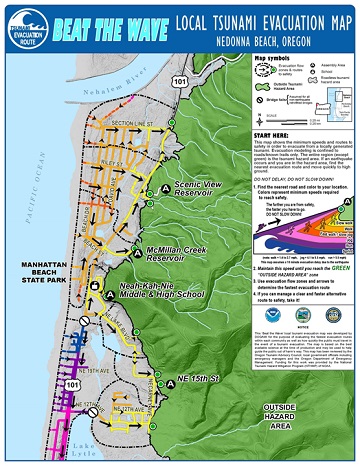March 11 marks the anniversary of the 2011 TÅhoku earthquake and tsunami in Japan
 T
The Oregon Department of Geology and Mineral Industries has released two new Tsunami evacuation modeling reports covering Astoria, Cannon Beach, Arch Cape, and Falcon Cove in coastal Clatsop County. The reports are part of the Beat the Wave series of publications and complete the evacuation modeling for Clatsop County.
Beat the Wave reports provide information about tsunami wave arrival times, evacuation routes, and minimum evacuation speeds that pedestrians must use to reach safety in the event of a Cascadia Subduction Zone earthquake.
A tsunami caused by an earthquake along the Cascadia Subduction Zone could impact coastal communities in as little as 10 - 20 minutes, so moving to higher ground quickly is essential. In some cases, the only warning that a tsunami is imminent will be the shaking caused by the earthquake. The shaking may damage roads, bridges, and other routes residents and visitors might use to get to safety so the best way to evacuate will be on foot.
“Knowing about and practicing evacuation for locations in the tsunami zone where you live, work or play are critical for keeping you and your loved ones safe in a Cascadia event,†says Laura Gabel, Coastal Geologist with DOGAMI. “These reports and ‘Beat the Wave’ evacuation brochures are of great importance for assisting emergency managers, community leaders and the public prepare for Cascadiaâ€.
In coastal towns like Astoria and Cannon Beach, many homes, businesses, and tourist attractions are located in tsunami inundation zones, making it very important for community members and visitors to familiarize themselves with evacuation routes. With the lifting of pandemic-related restrictions, tourism on the Oregon coast will likely increase in the coming months and it is important to ensure that visitors and residents have the information they need to prepare for a possible tsunami.
--Staff Reports| Post Date: 2022-03-13 14:01:02 | Last Update: 2022-03-13 16:31:31 |






 The Oregon Department of Geology and Mineral Industries has released two new Tsunami evacuation modeling reports covering Astoria, Cannon Beach, Arch Cape, and Falcon Cove in coastal Clatsop County. The reports are part of the Beat the Wave series of publications and complete the evacuation modeling for Clatsop County. Beat the Wave reports provide information about tsunami wave arrival times, evacuation routes, and minimum evacuation speeds that pedestrians must use to reach safety in the event of a Cascadia Subduction Zone earthquake.
The Oregon Department of Geology and Mineral Industries has released two new Tsunami evacuation modeling reports covering Astoria, Cannon Beach, Arch Cape, and Falcon Cove in coastal Clatsop County. The reports are part of the Beat the Wave series of publications and complete the evacuation modeling for Clatsop County. Beat the Wave reports provide information about tsunami wave arrival times, evacuation routes, and minimum evacuation speeds that pedestrians must use to reach safety in the event of a Cascadia Subduction Zone earthquake.